CROATIA - Split
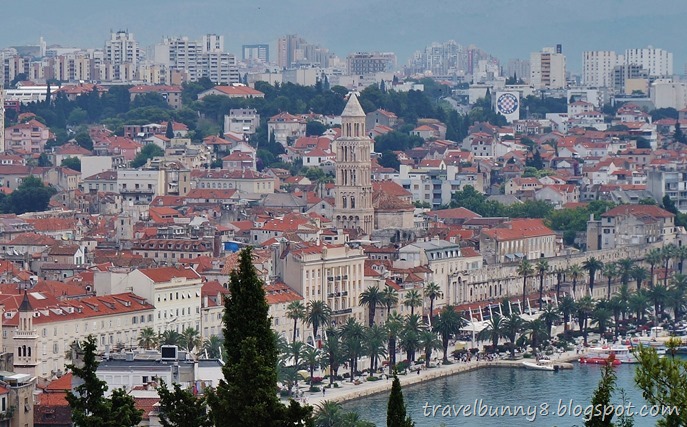
Split is the largest city of the region of Dalmatia and is the second largest city of Croatia. Founded in the 4th Century BC, Split houses the Diocletian’s Palace which is known to be the most complete remains of a Roman palace. While other Roman palaces lies in ruins, here in Split you can actually see an actual Roman palace. The Historical Complex of Split with the Palace of Diocletian is a UNESCO World Heritage Site.

Panoramic view of Split.
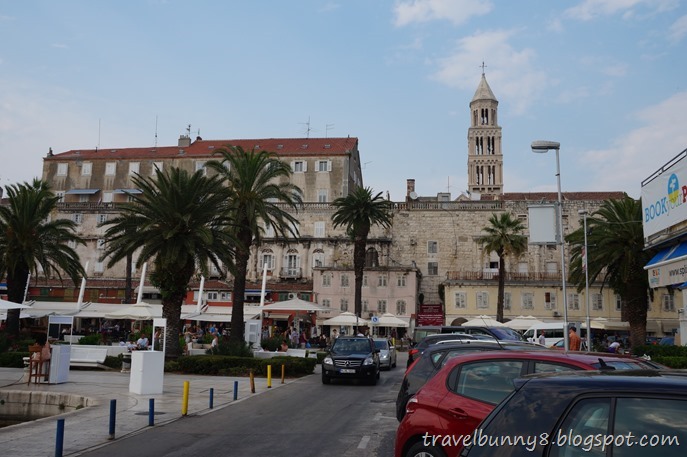
I arrived at Split in late noon.
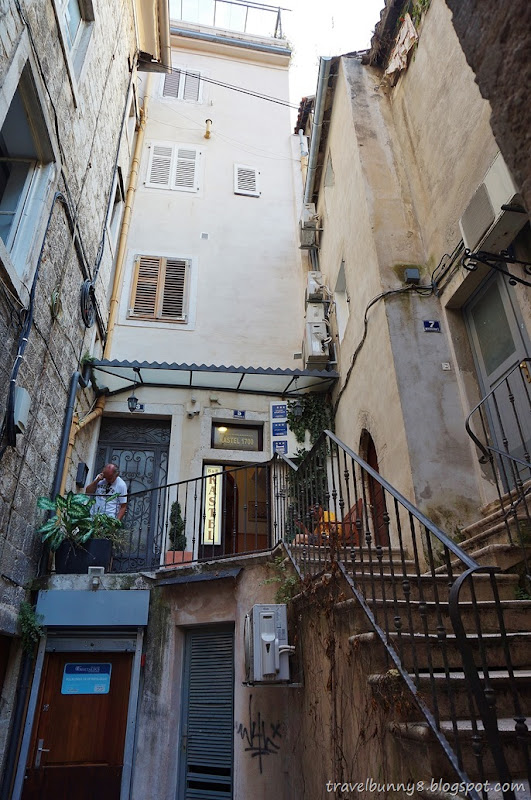
The first thing we did was to check in to our hotel, Hotel Kastel. I stayed here for two nights. There are two types of views to choose from, the square view and the sea view. The hotel has no lift and we had to carry our luggage all the way to the room at third floor.
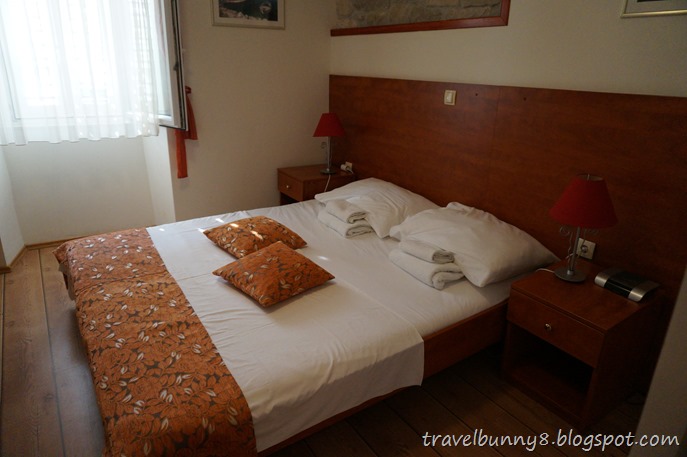
The hotel is located in the palace. Meaning to say, I actually spent two nights within the Diocletian’s Palace walls!

They prepared a baby cot for my son.
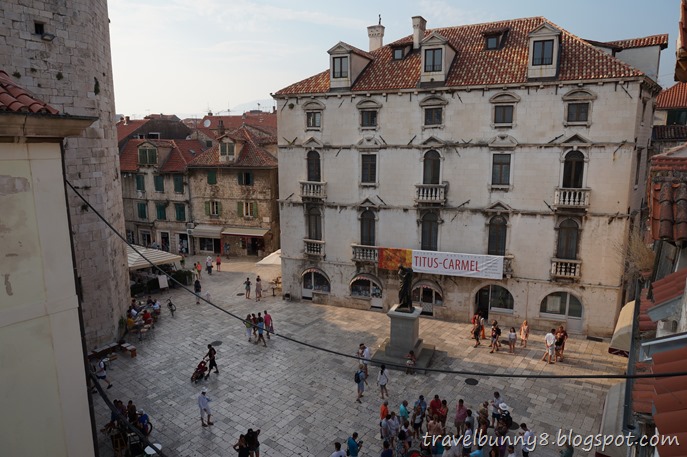
For the first night, I checked into the ‘square view’ room.

What we didn’t expect was the floor was slanted (the building is slightly tilted) , my son lost balance and knocked his face to the toilet door frame. Fortunately he was not hurt seriously.
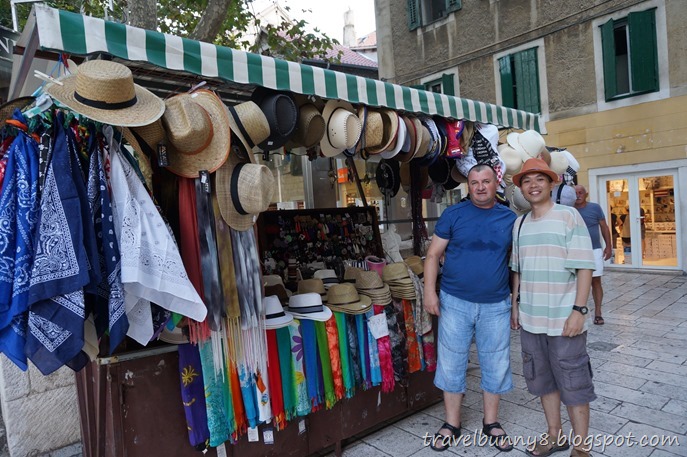
First, my hubby bought a hat at this stall. He couldn’t stand the heat of the sun without a hat.

My son trying on a hat at the stall.
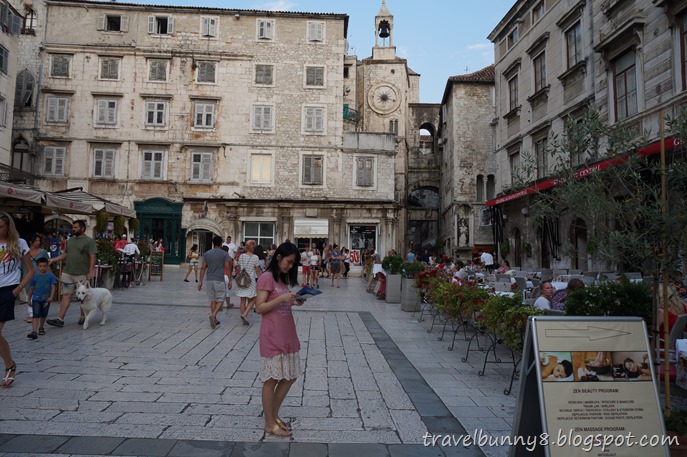
We spent the evening taking a walk in the Diocletian’s Palace compound. The palace was like a maze.

There are four main gates in the palace: Golden Gate, Silver Gate, Brass Gate and Iron Gate. This is the Iron Gate.
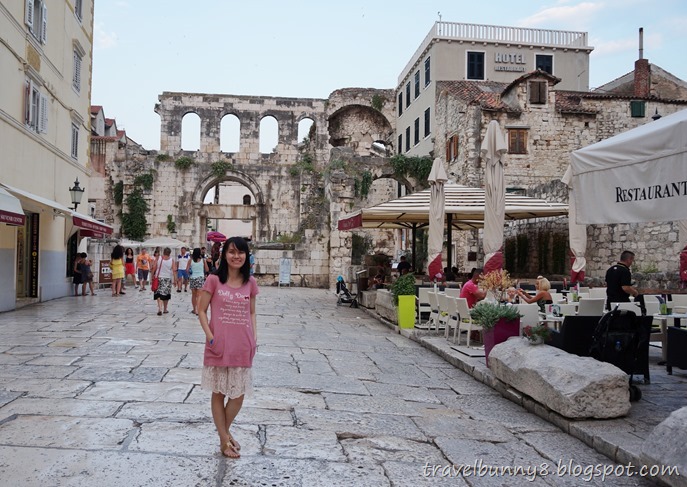
And this is the Silver Gate.

Behind me is the famous Cathedral of St. Dominus and its bell tower.
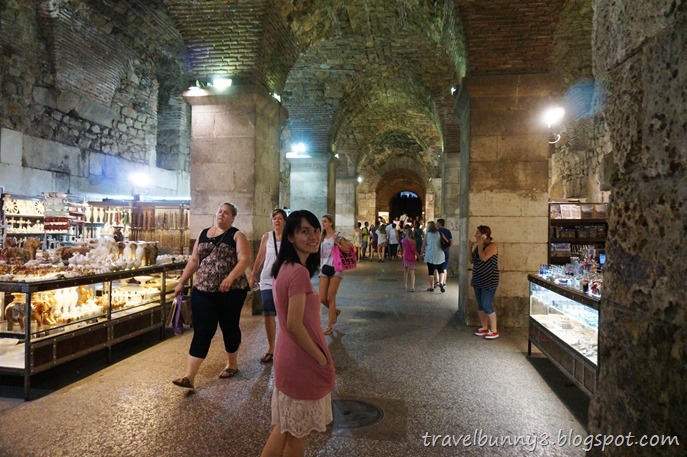
Then I entered through the Brass Gate which lead me to the souvenir shops in the basement halls.


During the excavations in the period between 1955 – 1965, two ancients wells were found by researchers of Institute for Town Planning.

Despite the sign that prohibit people from throwing coins into the well, people still do.

We bought tickets to enter the basement halls of Diocletian’s Palace.
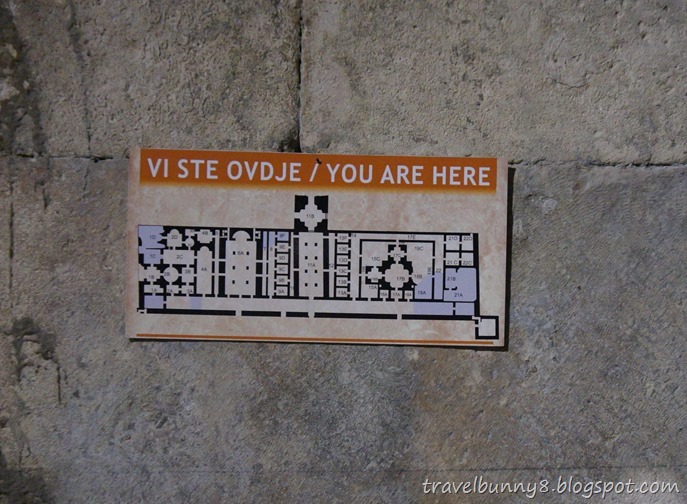
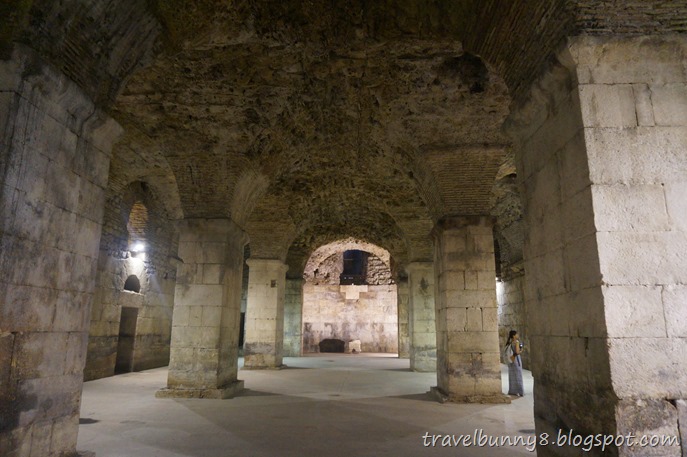
The basement halls showcase the substructure of the Diocletian’s Palace, consisting of many rooms and walls as supporting walls for the employer’s residents above.

The acoustic of a circular room like this is impeccable.
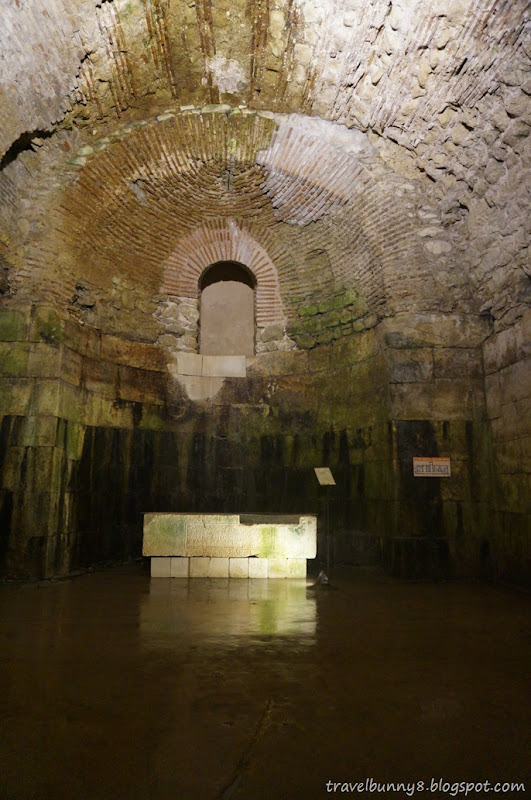

This is the pressure system to produce olive oil.
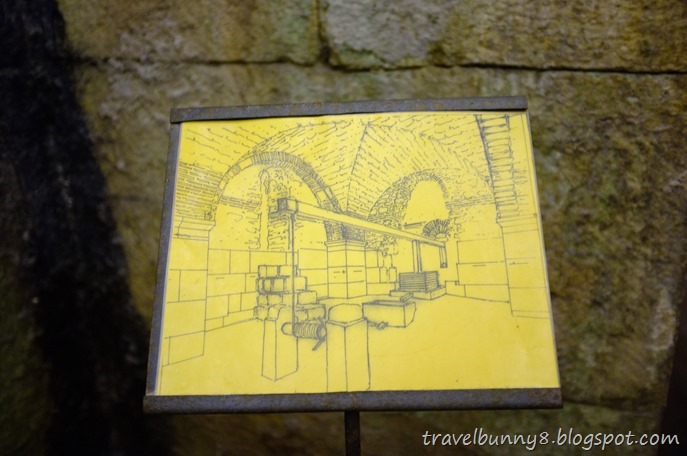
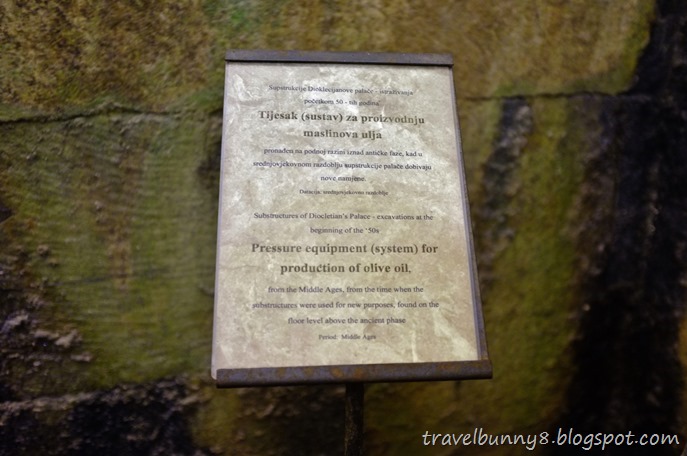
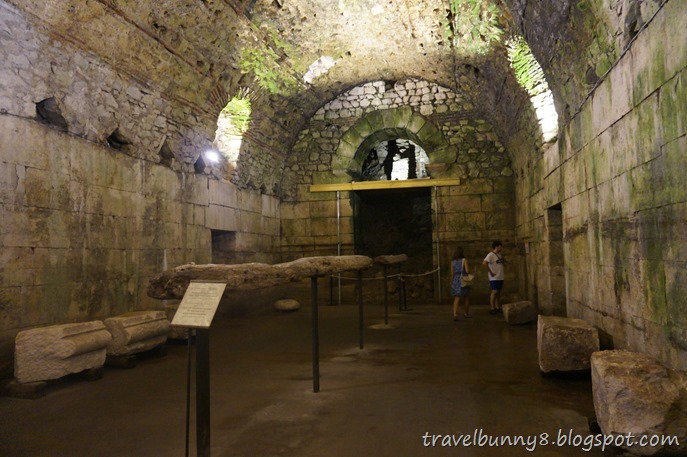
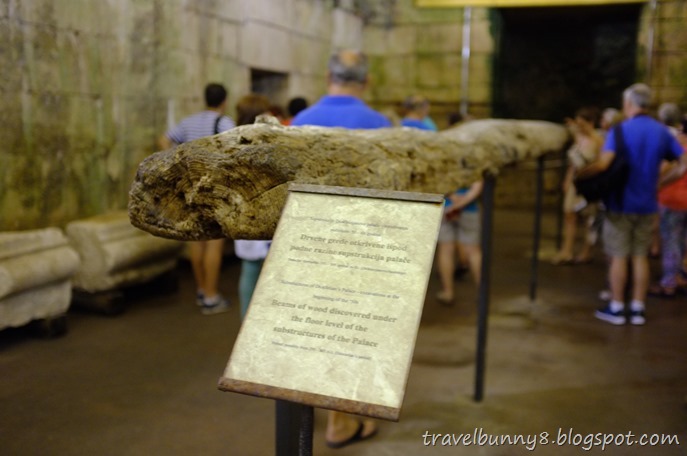
A wooden beam found under the floor level of substructure of the palace.

Part of the basement halls are used to display art works.


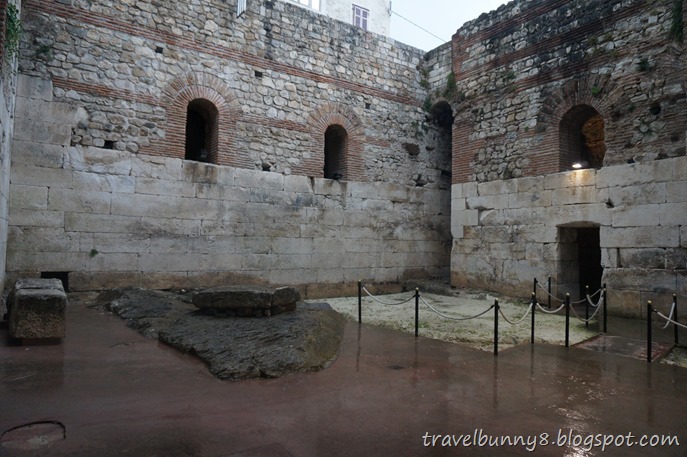
After the time of Diocletian, the basement was filled with dirt and sewage until excavated in the 1850’s.

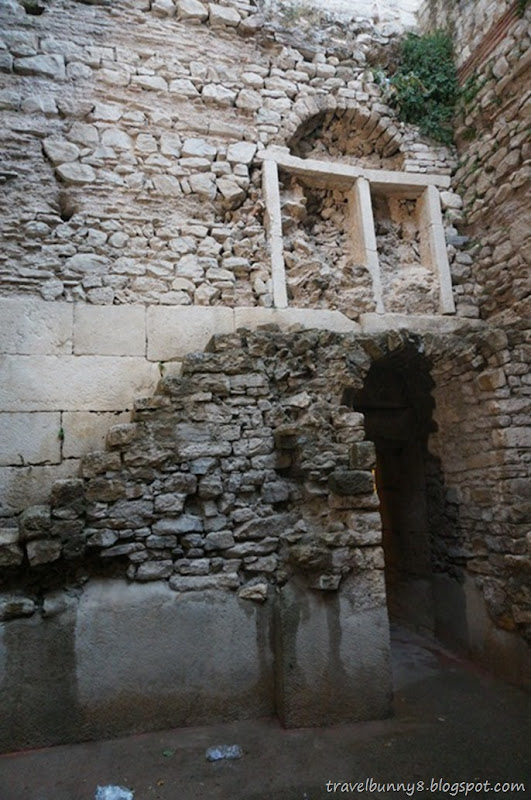

It’s time for dinner!

I settled for a restaurant in one of the alleys.
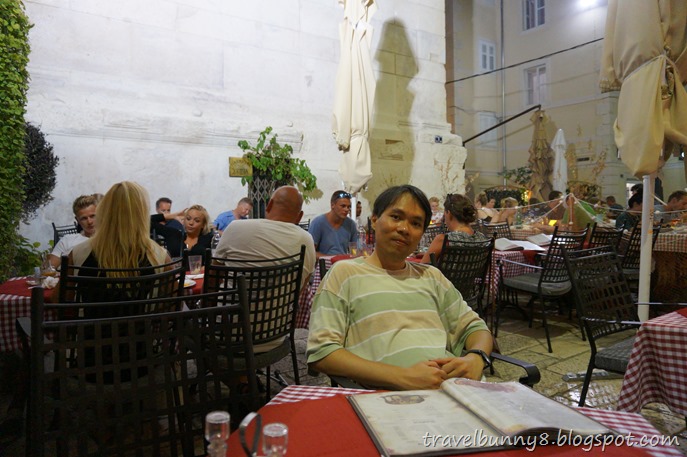
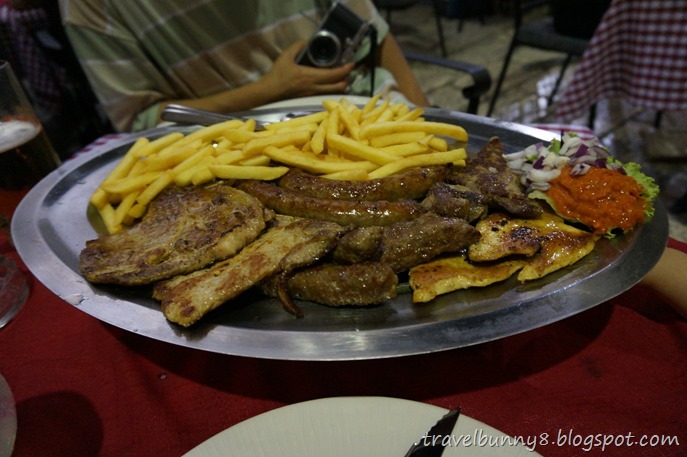
We ordered a meat platter which would make any meat eater happy.

After dinner, we called it a day and returned to the hotel.
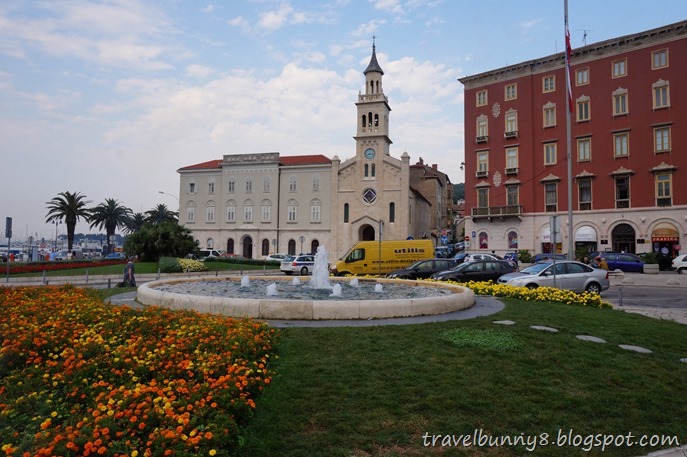
A grand fountain was once located here in the late 19th century. The fountain was destroyed in 1947 by city authorities as a symbol of fascism and Italian occupation. Now only this dull fountain remains.
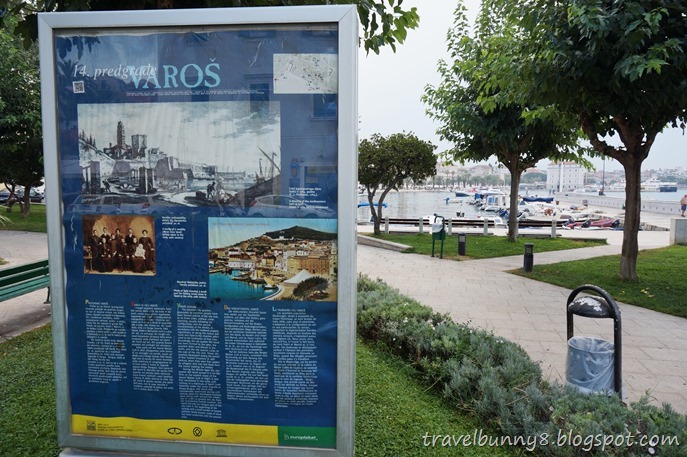
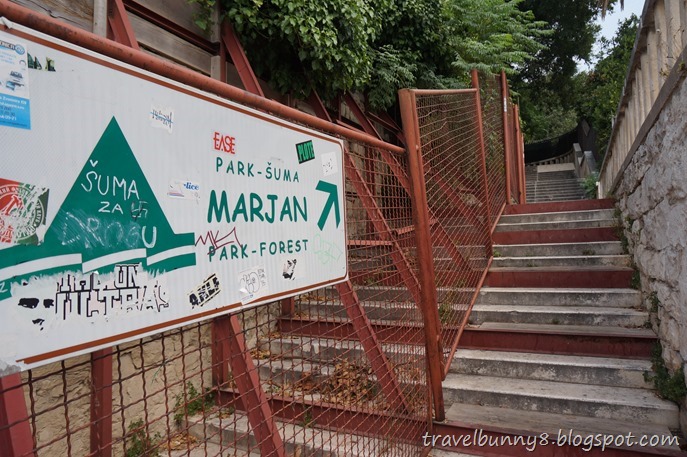
This way to the Marjan Forest Park. It is considered as the ‘lungs of the city’.
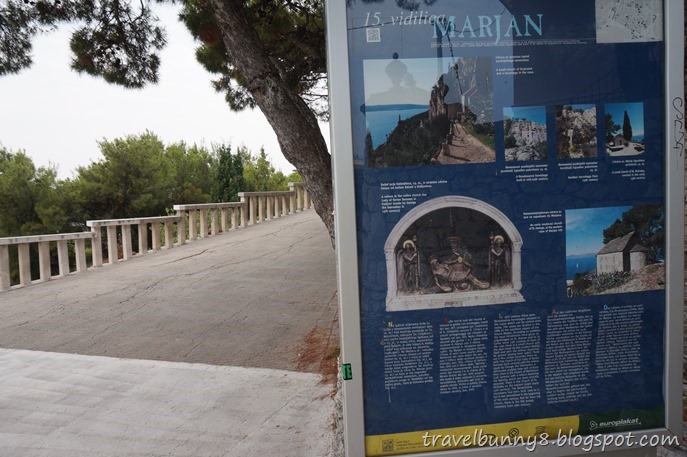
Located on the west side of the city is Marjan hill.
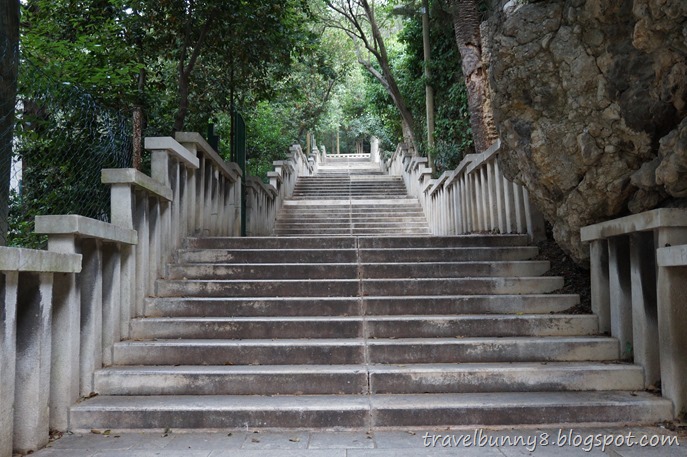
After maybe 200 hundred steps up the staircase and hiking up the hill,……..
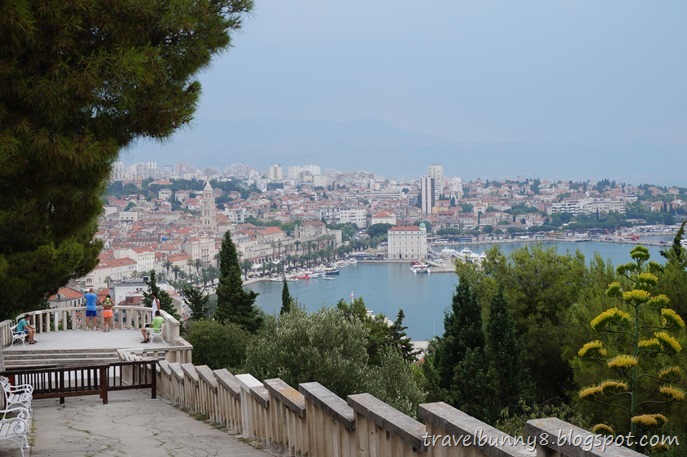
…….I was rewarded with a beautiful view of Split.

Marjan Hill offers a commanding and beautiful view of the city.

The forest of Marjan.

The church of St. Nicholas erected in the early 13th century.
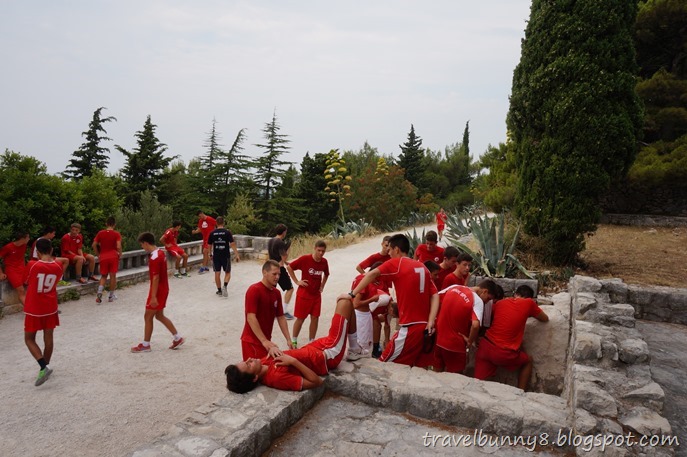
The hill is actually used as a park by locals as early as the 3rd Century.
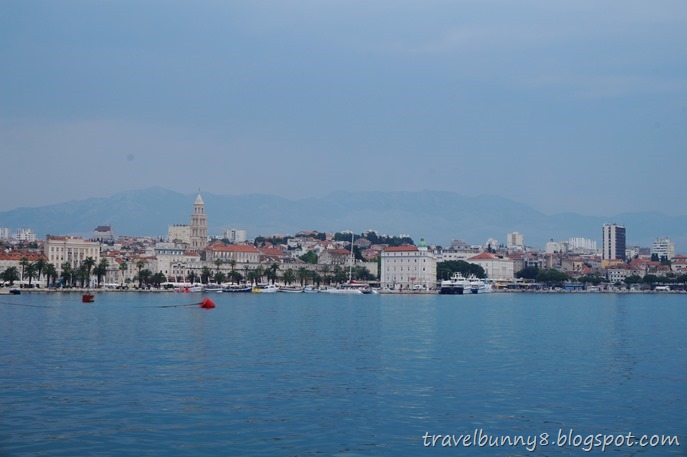
Time to head back to the city.
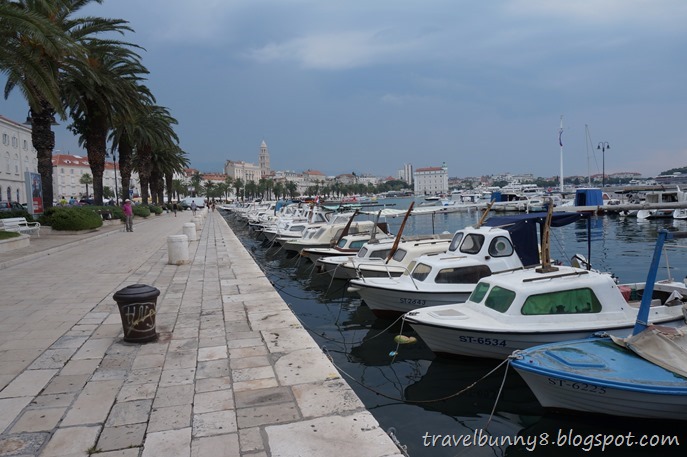
The Riva, the main city promenade.


The Peristil Square is the main square of the Diocletian’s palace with a very well preserved Roman architecture. It is also a central gathering place in the old part of town and often a venue for concerts, plays and etc.

The Grisogono Palace was part of a large Romanesque family palace of the 13th century.

Taking a photo with two Roman soldiers. You have to tip them of course.

The imposing bell tower is also another famous attraction at the square.

Originally built around the year of 305 as a mausoleum for the emperor Diocletian, the St. Dominus’s Cathedral is a very beautiful mixture of a Roman temple and a Catholic church. It was converted into a cathedral in the mid 7th century.

The St. Dominus Cathedral still retains its 13th century wooden doors.

Entrance fees for the St. Dominus’s Cathedral, crypt and baptistery only is 25kn. You can also buy a combo ticket for Cathedral, bell tower, crypt, baptistery and treasury for 45kn.
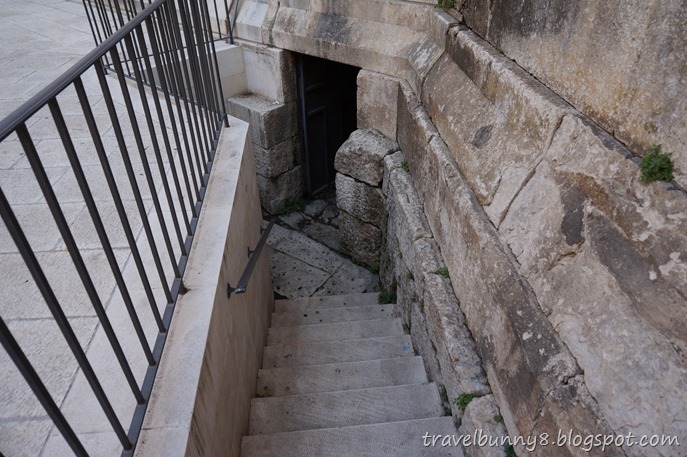
Entrance to the crypt.
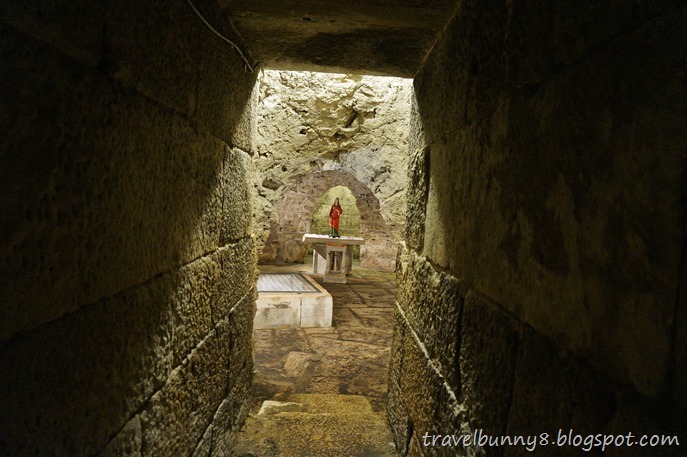 v
v
The crypt’s inside view.
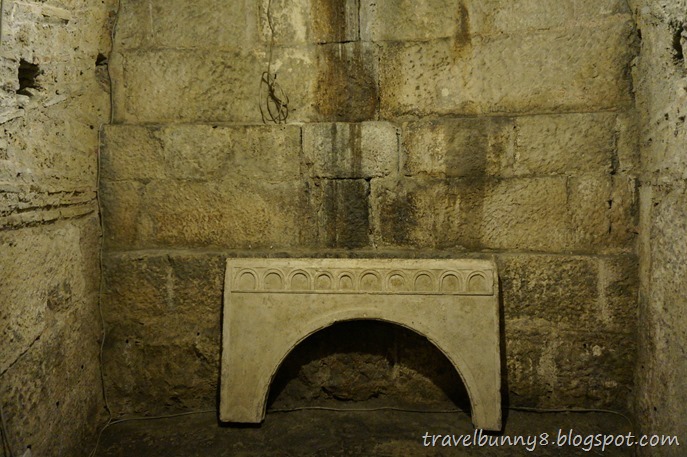
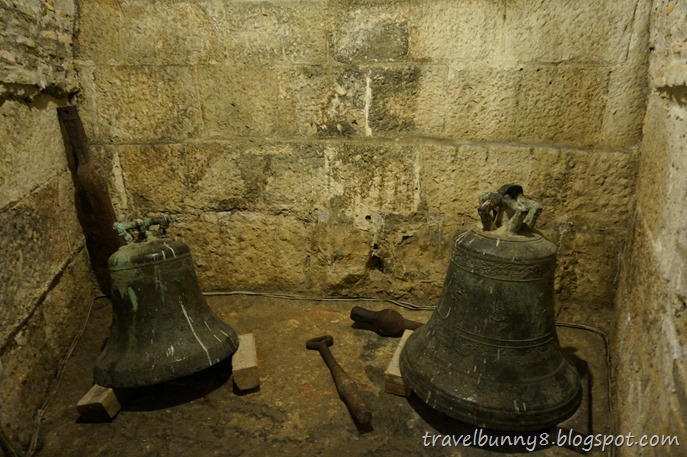


Interior of St. Dominus’s Cathedral.
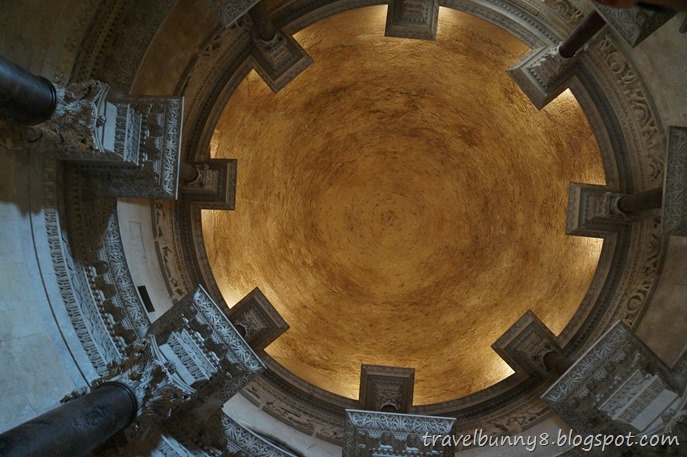
The original octagonal shape of the mausoleum was preserved although the dome ceiling no longer bears glittering mosaics.
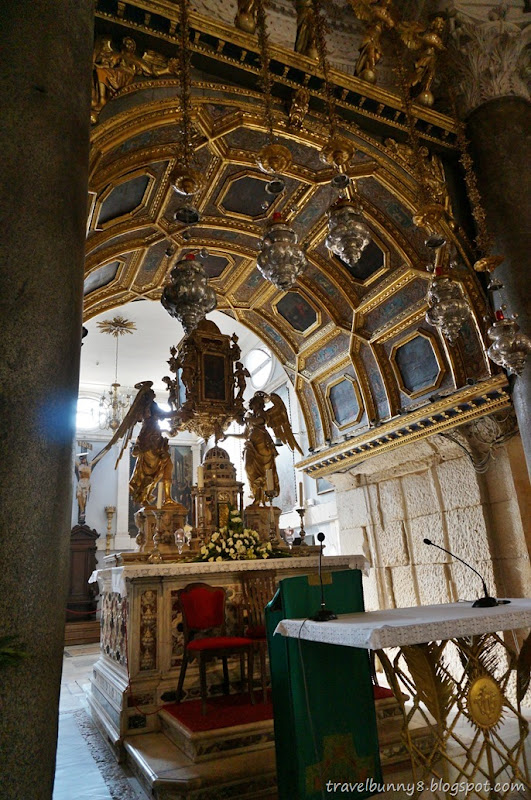

The main altar was built in the late 17th century.

It bears 10 beautiful scenes from the old Testament. The right altar is dedicated to St. Dominus, a Christian martyr and 3rd century Bishop of nearby Salona. He was prosecuted under the rule of Diocletian.
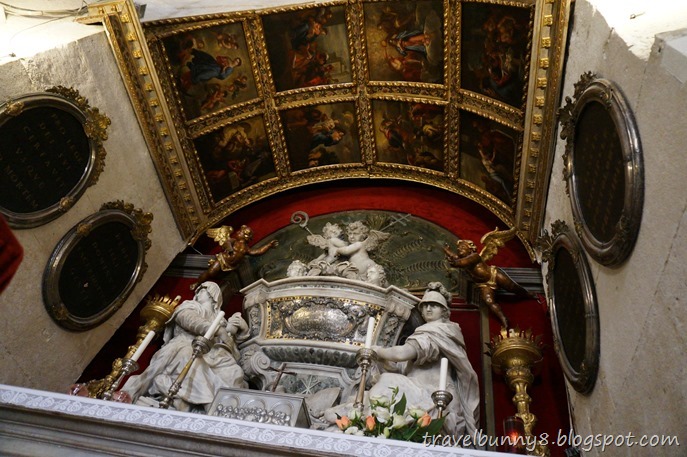

This is the treasury where you can find art works, 13th century chalices and containers, ancient garments and books dating back to the 6th century.

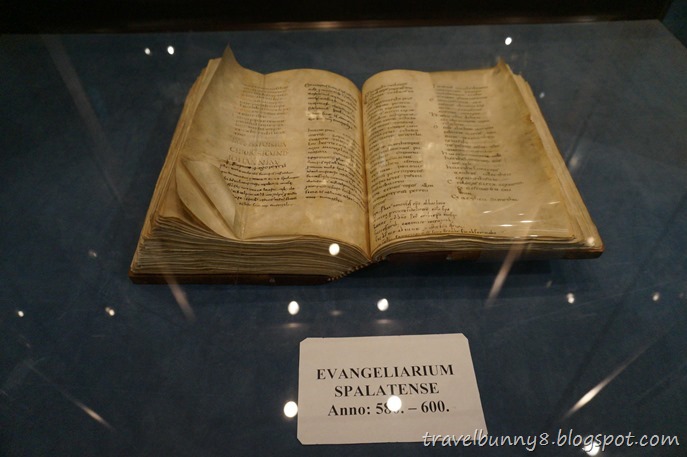


Construction of this 57m bell tower started in the 13th century and supposedly went on for 300 years until completion. At the foot of the tower are two stone carved lions that guard the entrance.
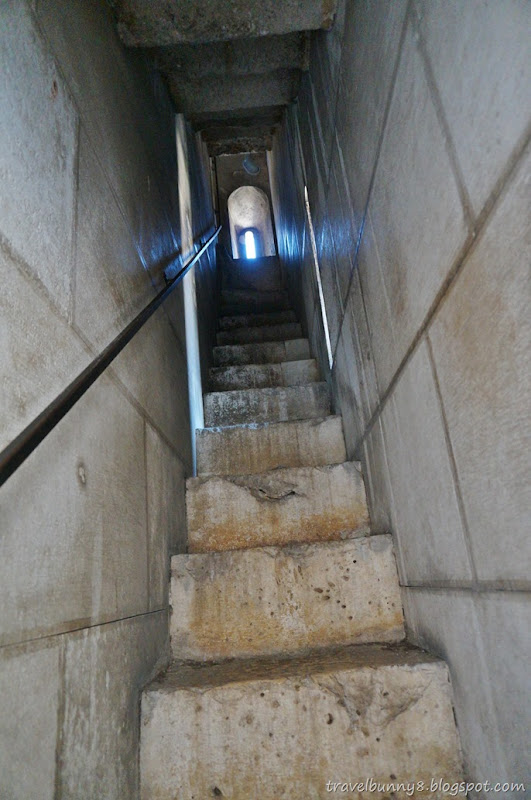
The narrow staircase in the bell tower.



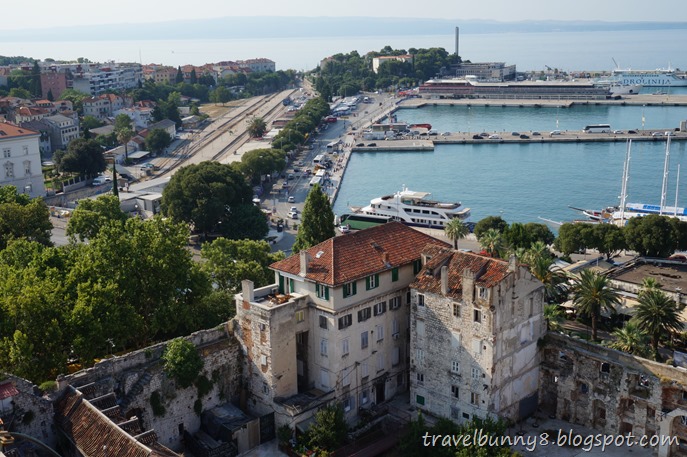


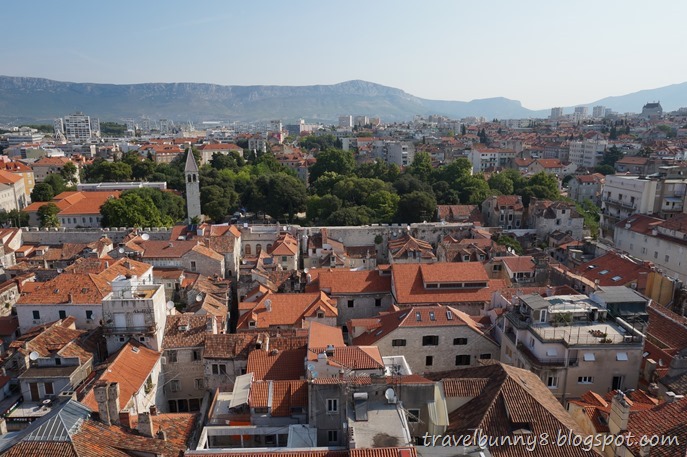
The breath-taking 360 degree views of the city once reached the top of the tower.

Just west of the Peristil, is the Jupiter Temple. Outside the entrance is a headless granite sphinx which Diocletian bought from Luxor. The entrance fees to the temple is 10kn.

Originally there were 3 temples here: Kibel, Venus and Jupiter. However, only Jupiter Temple remains today. The Jupiter Temple was built around the 3rd century. Jupiter was the name of Diocletian’s father and also the god of sky and thunder.

At the fall of Roman Empire, the temple was converted into St. John’s Baptistery. The two stone tombs are where the remains of Bishop John and Bishop Lawrence lie. In between the two coffins is a large statue of John the Baptist.
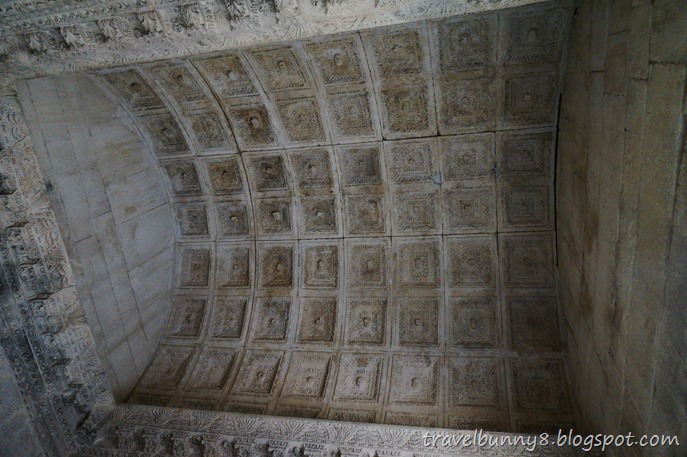
The ceiling of Jupiter Temple features stone blocks, each with a different central motif.
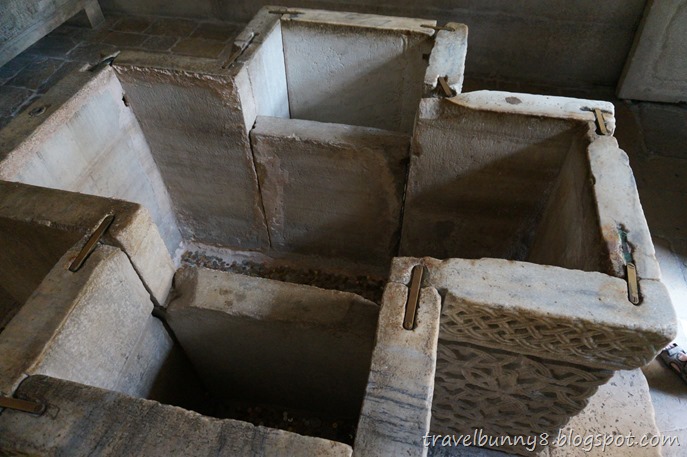
This font is used by visitors who make a wish by tossing a coin.
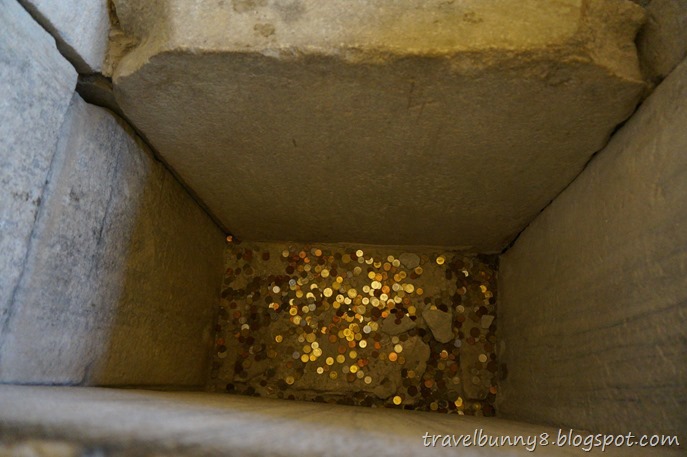
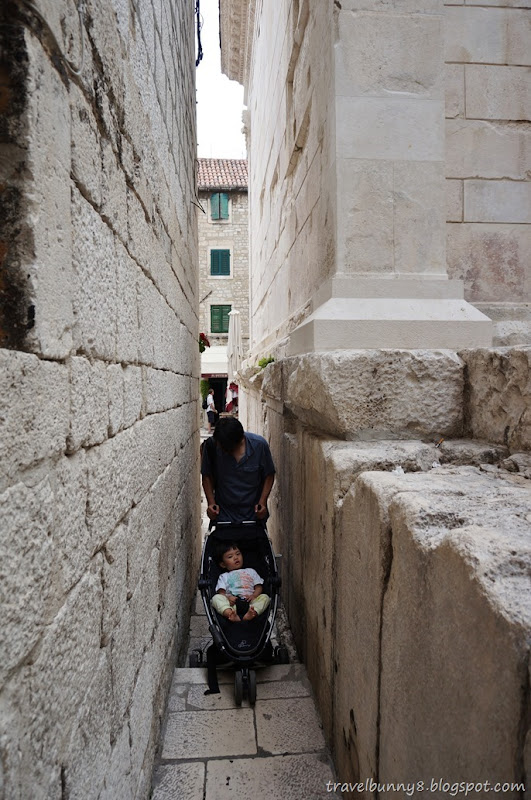
Directly next to Jupiter Temple is the narrowest street in Split called “Pusti me proc”, meaning “let me through”. Luckily my son’s stroller still managed to get through.
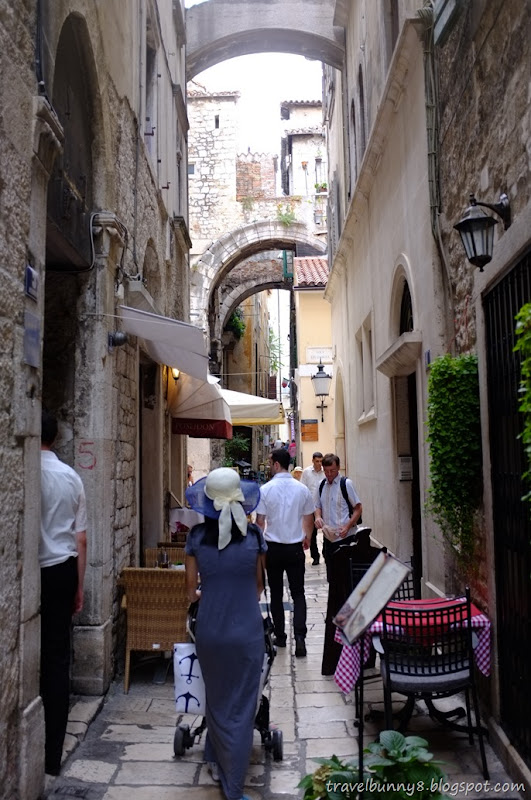


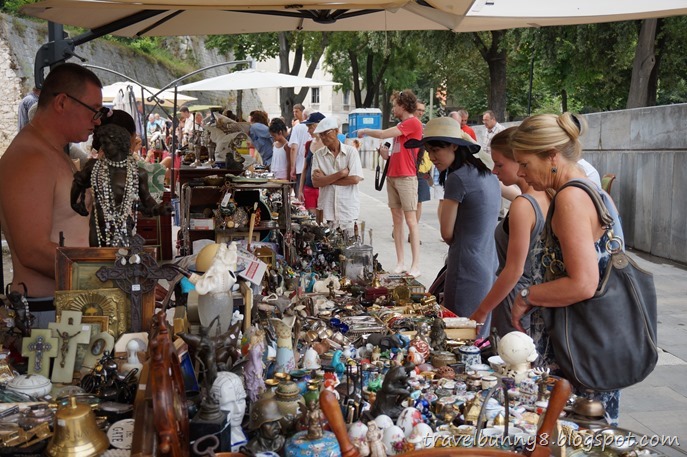
Flea market selling antiques, located just outside the Golden Gate of the palace.
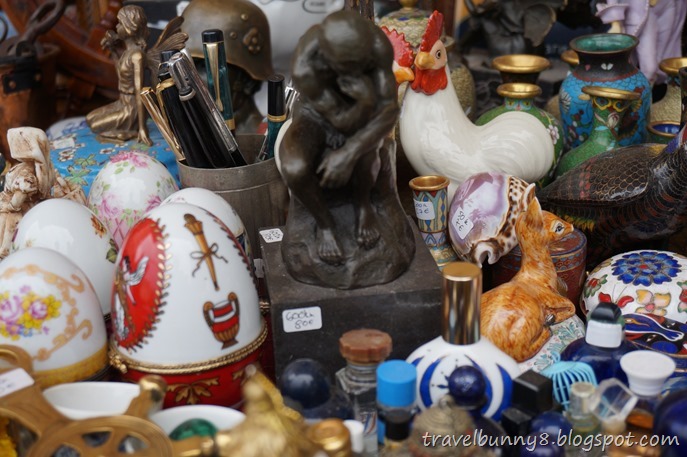
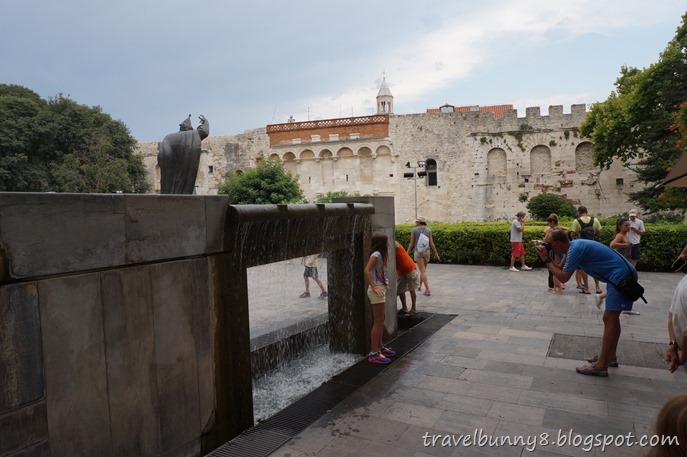
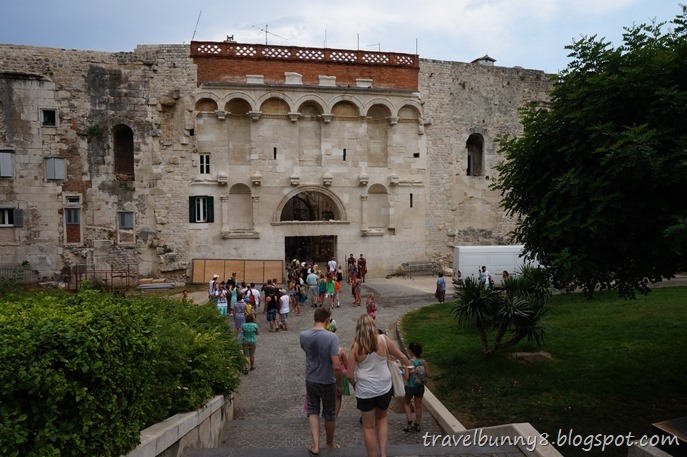

The Golden Gate is the main entrance of the palace and was used by the emperor when he entered his new home.
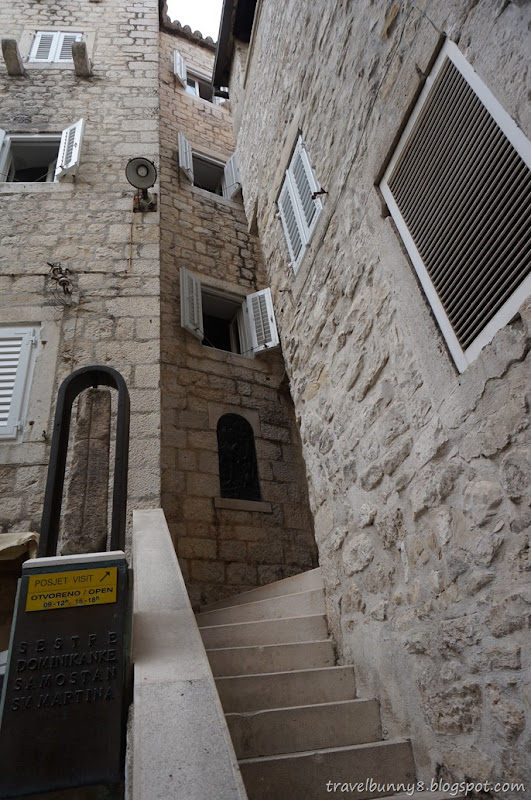
Sitting above the gate is the Chapel of St. Martin (5th century). One can access the chapel by a narrow staircase by turning right after passing the gates.

This miniscule chapel measures just 5 meters in width and it was built for the troops who guarded the gate.
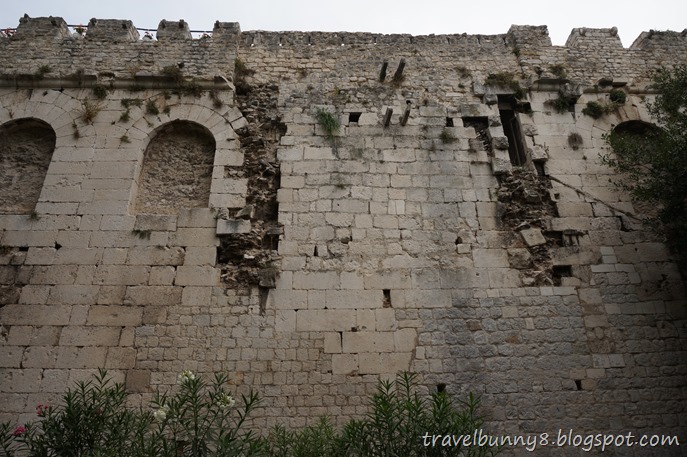
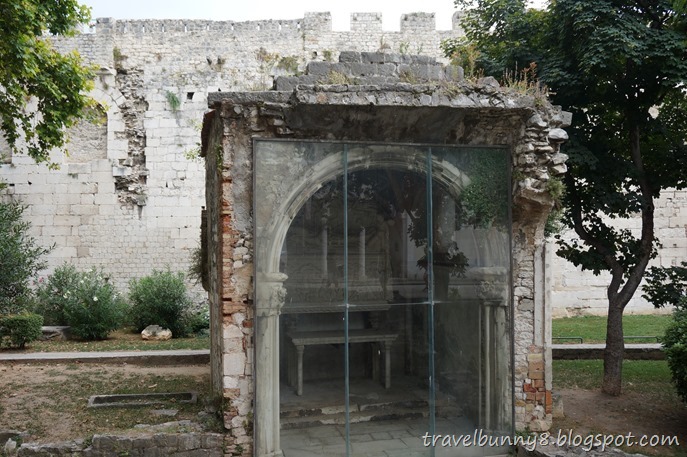
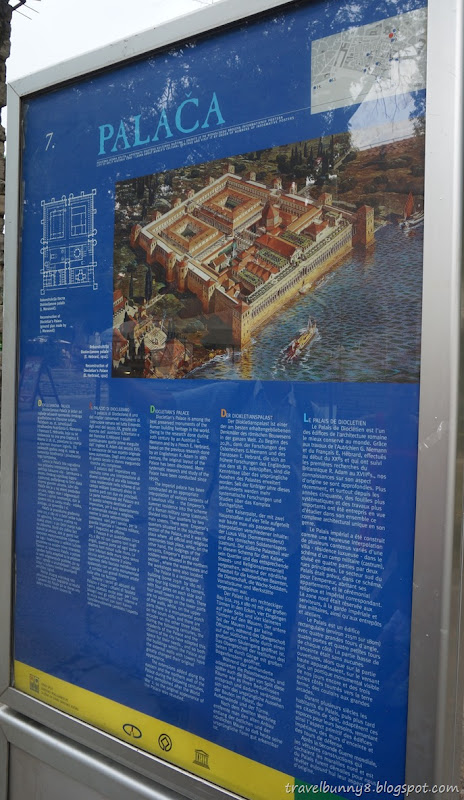
The layout of Diocletian’s Palace. The city has originally sprawled around the Diocletian’s palace, which was a palace and fort built for the retired Roman emperor Diocletian in the year 305.
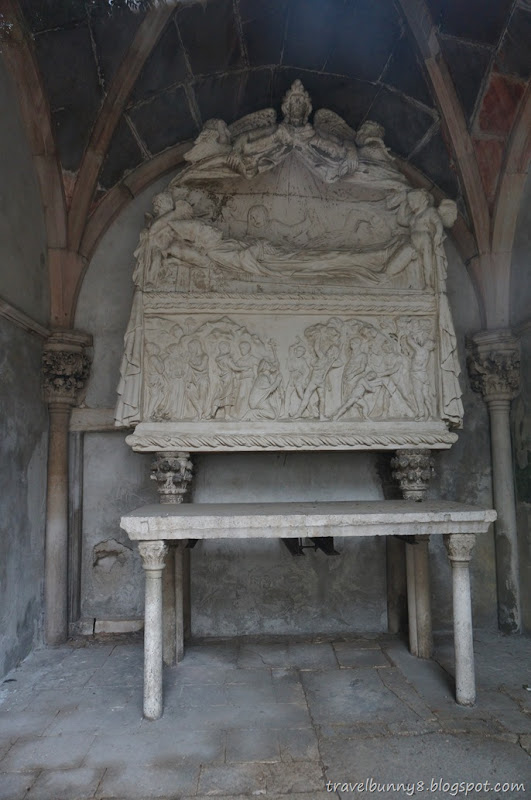
Diocletian was the first and only Roman emperor abdicate voluntarily. He lived in this palace till his death in the year 311.

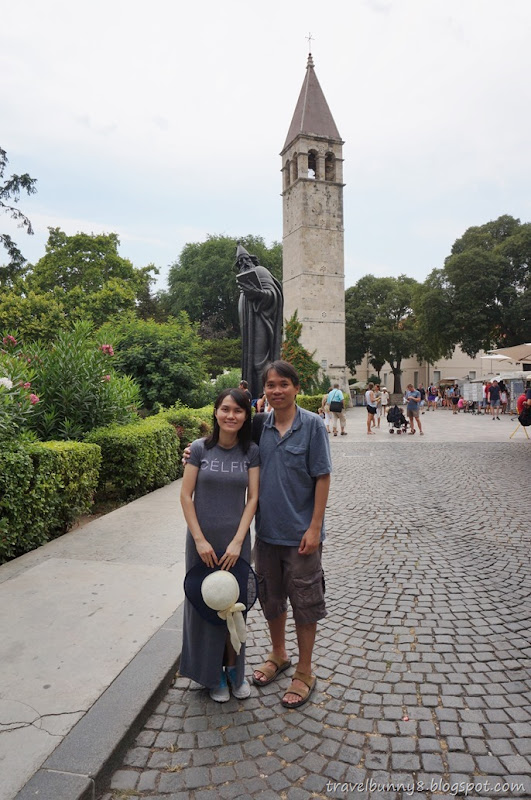
Behind us is the tall sculpture of Gregorius of Nin. This 10th century Croatian bishop fought for the right to use old Croatian in liturgical services.

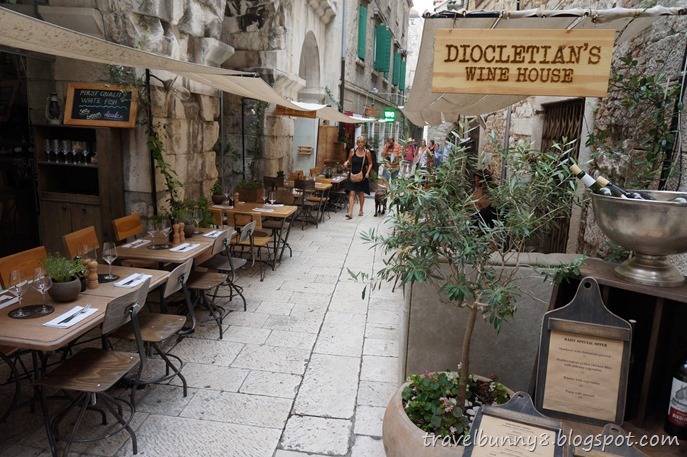
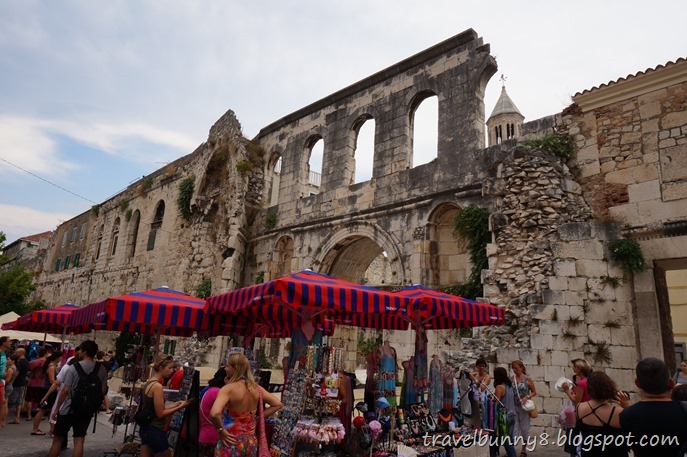
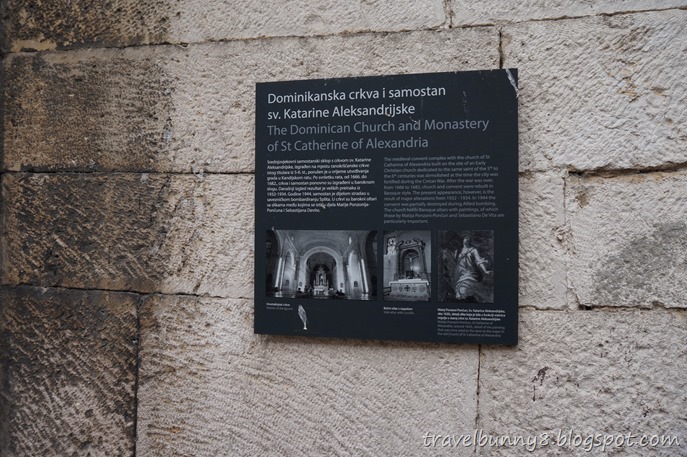

The interior of Dominican Church and Monastery of St. Catherine of Alexandria.


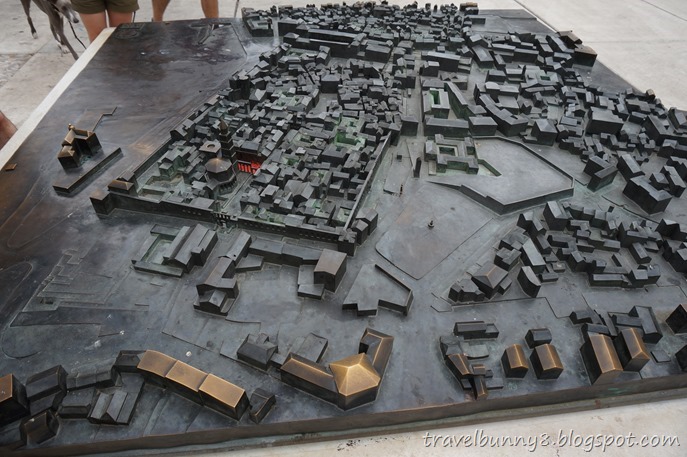
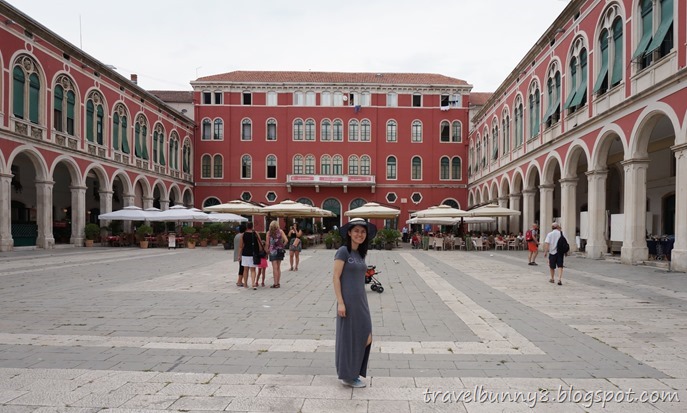
The Republic Square is a large open square, just west of Riva. It is surrounded by an elaborate red neo-Renaissance structure called Prokurative on three sides.
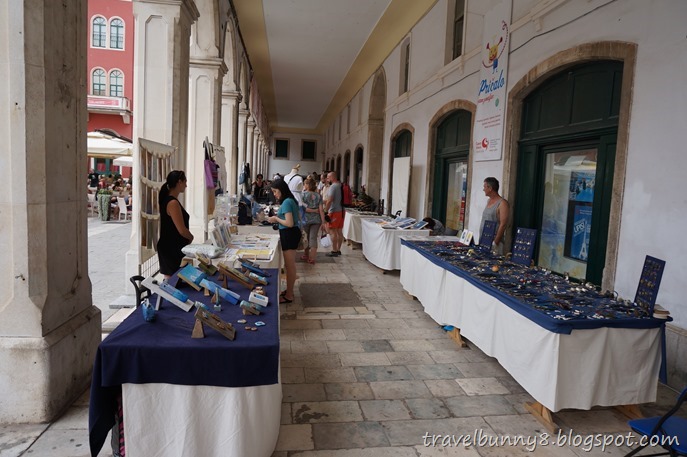
People selling handmade stuffs along the corridor.
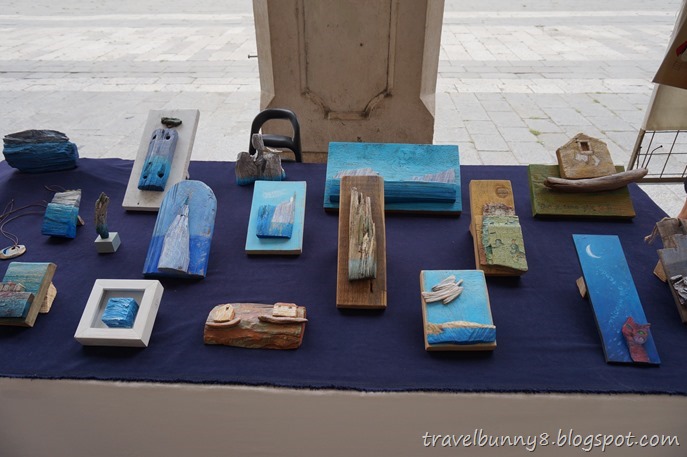
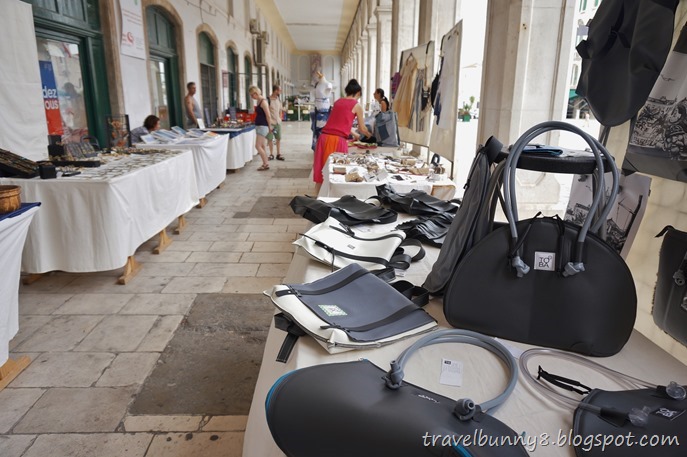
The handmade bags on the left are made with car seat’s material.
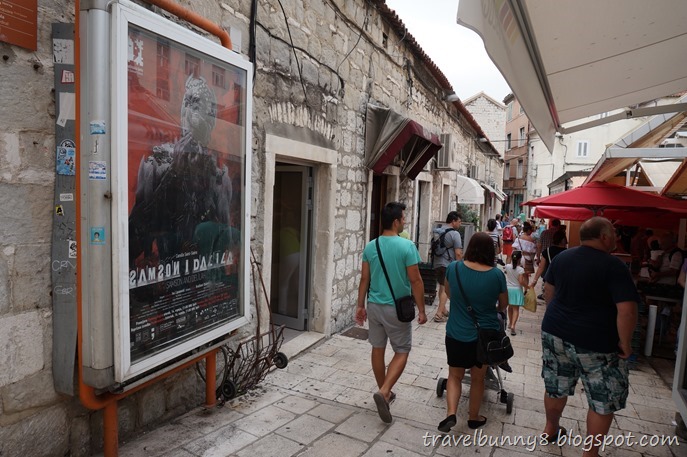


Croatian National Theatre in Split. It is one of the oldest surviving theatre in Dalmatia. We left around noon to visit Klis Fortress and came back to Split in the evening.


Riva is littered with terraces of numerous restaurants and cafes. This was where we had dinner on our second night in Split.

We ordered a seafood platter this time. Yummy!
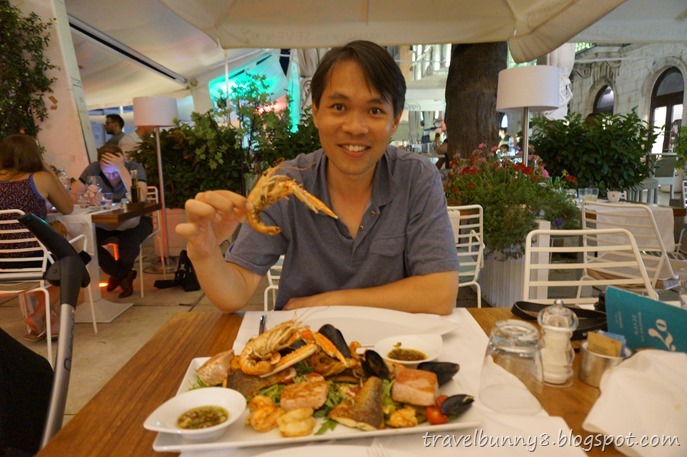
Bon Appetite!
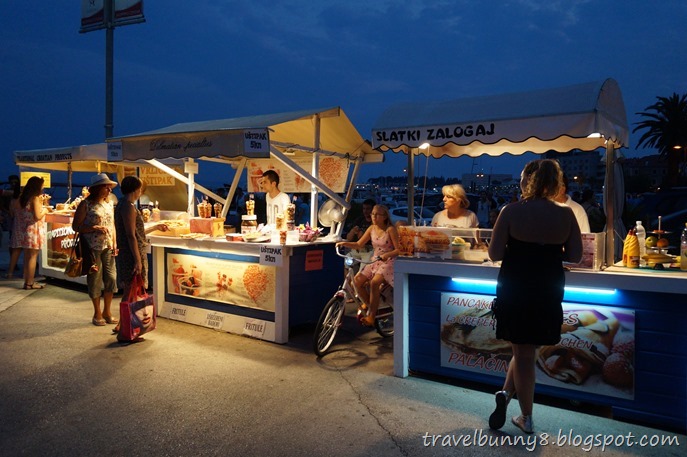

What better way to end a dinner than with a nice dessert? I got some delicious Dalmatian sweet delicacies which tasted like mini donuts with the choice of nutella topping.
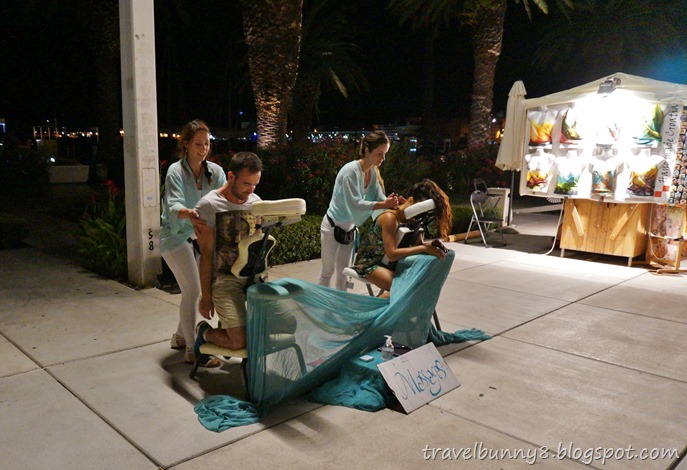
Fancy getting a massage on the street? You can do so at Riva.
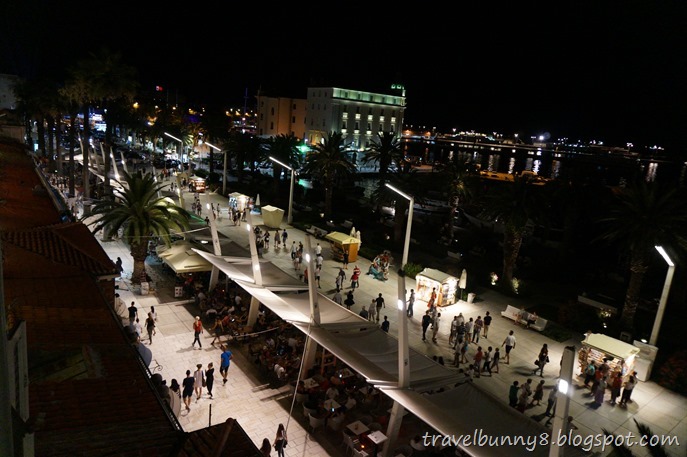
I really enjoyed my time in Split. Among the places I have visited in Croatia, Split is definitely my favourite. Goodnight, the craziest city in the world!



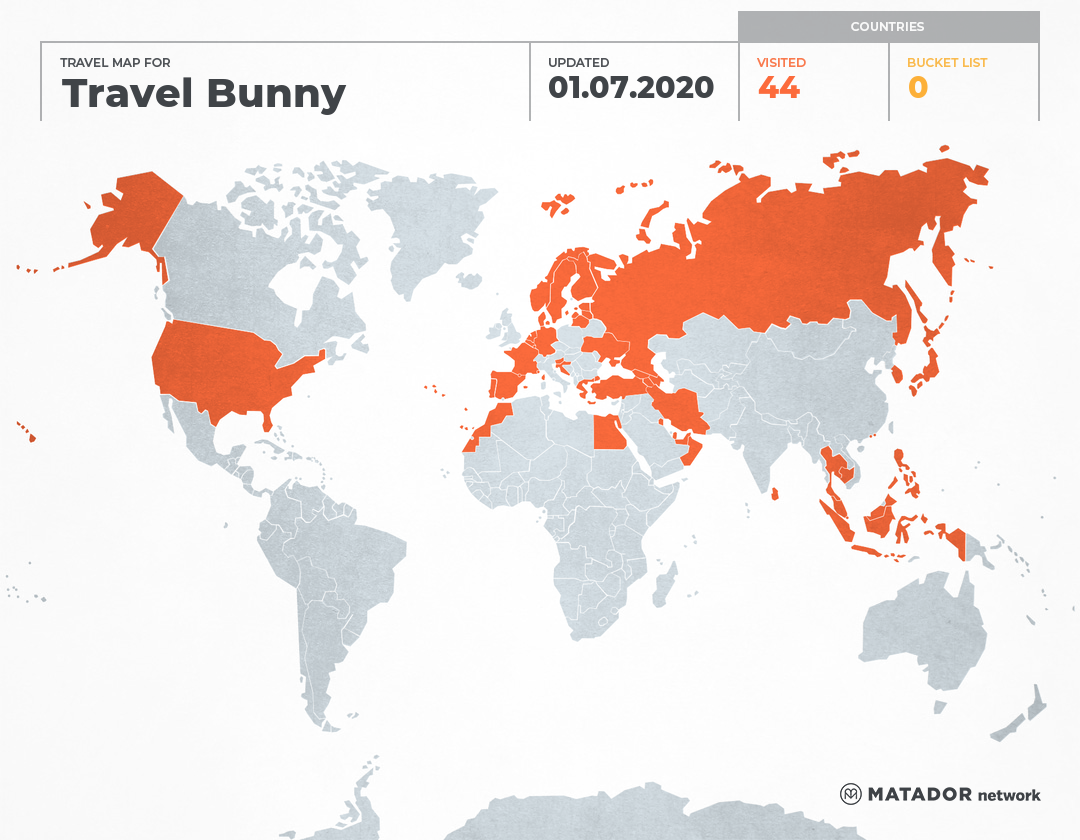
![[MALAYSIA] How To Do A Self Guided Walking Tour in Kota Kinabalu](https://blogger.googleusercontent.com/img/b/R29vZ2xl/AVvXsEgR_cJjX4Shl9rsz0ufzxjmtLMq5PAvmTNDHypSVV2CYDaarZVj8EMznRkXqdVeCGg2yEMdFqPtI5rvrmMtJVSL1W9jqOtdCM2EFAc5ZTWn7XzPQV5sqS4s1DO0T_AuF0nq_dLQ53b9-ju3yyLJUrvU2TlhbmD4rDDV5-aPFaT2WEQZ1c257JXGUhyfsw/s72-c/20220524_131141.jpg)
![[MALAYSIA] Tips on Taking Instagrammable Photo at KL Street Art Lane (Map Included)](https://blogger.googleusercontent.com/img/b/R29vZ2xl/AVvXsEjsKxlD3eU8SJeOolcscKEZjU-YtCIpk-geUR_avDri9-hyDIjRPGfKrOq_Qcbmkkm-HpTTdbI7rTpFzFo3wzWi7R27qdiOEOhcDLvZb-6x52rgkw_hxI8WIYT6tb6eLbmBZAFyOTpLkQNy/s72-c/collage+cover.jpg)
![[FRANCE] My Favourite Paris Eiffel Tower Photo Spots](https://blogger.googleusercontent.com/img/b/R29vZ2xl/AVvXsEi220KHLfBDpyO53KorHwAb0KQEuiiaVDlrFYwEEAvs8YvKb-Edmyt7Hl7rZszN6qc-GM4e3SmjBS2pUiCiv8ljl8mnrUR93Ljxb0xGrSZ4sZLPRErpbAj29btKvnIC67xV93iKnrH3QRcc/s72-w781-c-h505/DSCF4372.JPG)
![[FRANCE] My Unforgettable Trip to Mont Saint-Michel](https://blogger.googleusercontent.com/img/b/R29vZ2xl/AVvXsEiVPyy72HIGsb8lnH7zvmCT8fKDLby20OtHvFN2rAp_BWadwYBvOq3Ny-JtjTu1CTXP4rSHUxr7Z0yOgE7zFqDFwC2HEuCWp-F2ykSwXCFNeis4Q7a5IpyepHyfv9BXibLV2s8E-7mqMFx4/s72-c/DSC05363.JPG)
![[MONACO] How To Visit Monaco In One Day From Nice](https://blogger.googleusercontent.com/img/b/R29vZ2xl/AVvXsEgZkJeVAOmz4LTRwY2uDTK131UJVUWH_44GUUU3H-ni63dK2BlNqITBIh5Tdcpz9kXTUb7ePW7f-PQ1Y7E6B4lnqKEHs_nL3Eop-ouoFhxayMI4lNCcUG-oJnGMVwpGDlBu8lfgn10H_QHw/s72-c/DSC06605.JPG)
great post! best regards from Split!
ReplyDelete